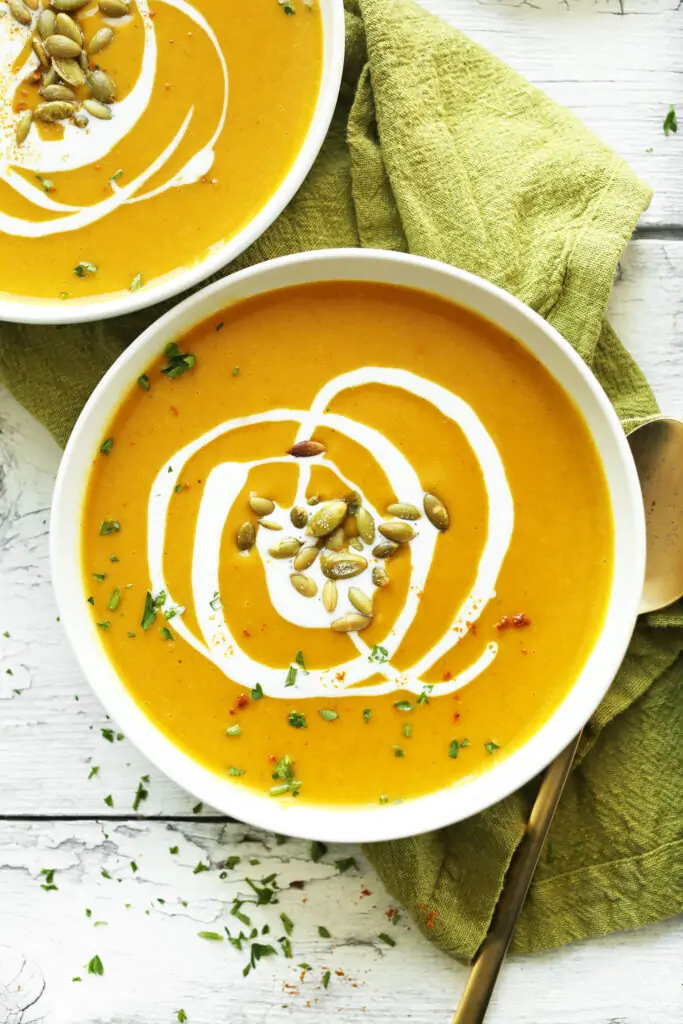Buttercup squash soup is a delightful and nourishing dish that heralds the essence of fall. This creamy soup, known for its rich, velvety texture and sweet, nutty flavor, centers around buttercup squash, a winter squash variety that stands out with its dark green skin and vibrant orange flesh. The soup’s simplicity allows the squash’s natural flavors to shine, complemented by a subtle blend of aromatic ingredients like onions, garlic, and a hint of fresh herbs such as thyme or sage.

The preparation of buttercup squash soup involves roasting or simmering the squash until it’s tender and full of flavor. This process enhances its natural sweetness, making it a perfect base for the soup. Blended until smooth, the squash pairs wonderfully with a splash of cream or coconut milk, adding a luxurious texture and richness. Seasonings like nutmeg or cinnamon can be added to accentuate the squash’s warming qualities, making the soup a comforting bowl of goodness on chilly days.
Buttercup squash soup is not only a feast for the taste buds but also a healthful choice. Packed with vitamins, fiber, and antioxidants, it supports overall health while providing a satisfying and heartwarming meal. Whether served as a starter or a main dish, this soup is sure to be a seasonal favorite.
How Does Buttercup Squash Taste?
Buttercup squash boasts a delightful flavor profile that makes it a cherished ingredient in autumnal and winter dishes. This variety of winter squash is appreciated for its dense, creamy texture that resembles that of sweet potatoes and butternut squash. When cooked, buttercup squash reveals a mildly sweet taste with hints of earthiness, which can be further enhanced through roasting or baking to bring out its natural sugars.
The flesh of buttercup squash is bright orange, indicating its richness in beta-carotene, which translates into a subtle sweetness similar to that of a pumpkin, but with a more pronounced nuttiness. This distinct taste makes it versatile in both savory and sweet culinary applications, ranging from soups and stews to pies and purees.
Its flavor is often described as more intense than that of other squashes, with a finish that has just a touch of bitterness, adding complexity to its overall palate. This characteristic makes it a favorite for those who enjoy a richer, deeper squash flavor that stands out in any dish.

How Does It Looks Like?
Buttercup squash is easily recognizable due to its unique appearance, which sets it apart from other winter squash varieties. It typically features a compact, round shape with a flat top and bottom, making it somewhat squat in appearance. The skin of the buttercup squash is dark green, often mottled with lighter green stripes or spots, giving it a distinctively earthy and rustic look.
One of the most notable features of buttercup squash is the small, circular ridge or “turban” on its blossom end, which looks like a cap. This turban is sometimes more pronounced in certain specimens and adds to the visual intrigue of the vegetable. The flesh inside is a vivid orange, thick and firm, packed with seeds in the central cavity, which can be removed easily.
Overall, the appearance of buttercup squash is not just appealing but also indicates its rich, dense texture, which is perfect for a variety of culinary uses. Its sturdy outer shell ensures that it holds up well during cooking, making it a favorite for baking, steaming, and incorporating into hearty winter meals.
Difference Between Buttercup and Butternut Squash
Buttercup and butternut squash are both popular varieties of winter squash, each bringing its own unique qualities to the table, both in appearance and flavor. Understanding their differences can help you choose the right squash for your culinary needs.
Appearance: Buttercup squash is typically round and squat with a dark green, hard exterior and a distinctive turban-like cap on its bottom. Its shape is more compact, making it slightly harder to peel. In contrast, butternut squash has a smooth, beige skin and a long, bell-like shape that tapers at one end. Its skin is thinner and easier to peel compared to the tougher skin of the buttercup squash.
Texture and Flavor: The flesh of buttercup squash is dense and creamy with a sweet, rich flavor that is slightly nutty. It is particularly moist, which makes it excellent for baking and pureeing. Butternut squash, while also sweet, tends to have a lighter, more buttery texture with a slightly less intense sweetness than buttercup squash. Its flesh is also smooth and creamy, making it versatile for both savory and sweet dishes.
Culinary Uses: Buttercup squash excels in recipes where a dense, creamy texture is desired, such as in soups, purees, or pies. Its moisture content helps it maintain a good structure without becoming too watery. Butternut squash is incredibly versatile, used in a wide range of dishes from roasts and soups to desserts and stews. Its ease of peeling and chopping also makes it a preferred choice for quick cooking.

Kitchen Tools Needed
Ingredients for Buttercup Squash Soup

How To Make Buttercup Squash Soup?
Preparing the Squash
Start by preheating your oven to 400 degrees Fahrenheit if you choose to roast the buttercup squash for a deeper flavor. Cut the squash in half, scoop out the seeds, and peel it. Chop the squash into cubes and, if roasting, toss them in olive oil, spread them on a baking sheet, and roast for about 30 minutes or until tender. Alternatively, you can peel, cube, and directly sauté the squash with other vegetables in the next steps.
Cooking the Vegetables
In a large pot, heat the olive oil over medium heat. Add the chopped onions, minced garlic, chopped carrot, and celery. Sauté the vegetables until they start to soften and the onions become translucent, about 5 to 7 minutes. This process builds a flavor base for your soup.
Simmering the Soup
Add the cubed buttercup squash to the pot along with the chicken or vegetable broth. Bring the mixture to a boil, then reduce the heat and let it simmer gently until all the vegetables are tender, about 20 to 25 minutes. If you roasted the squash, it would need less time to simmer as it’s already partly cooked.
Pureeing the Soup
Once all the ingredients are soft and the flavors melded, remove the pot from the heat. Using an immersion blender, puree the soup directly in the pot until it is completely smooth. Alternatively, you can transfer the mixture to a blender in batches and blend until smooth. Be careful when blending hot liquids as they can splatter.
Finishing Touches
Return the pureed soup to the pot if you used a blender. Stir in the heavy cream or coconut milk for a richer, creamier texture. Add chopped fresh thyme or sage if using, and season with salt, ground black pepper, and a pinch of nutmeg or cinnamon to enhance the flavors. Heat the soup over low heat just until everything is warm.
Serving
Serve the buttercup squash soup hot, garnished with a sprinkle of fresh herbs or a drizzle of cream if desired. This soup pairs wonderfully with crusty bread or a light salad for a complete meal. Enjoy the comforting flavors of this seasonal delight!

What To Serve With Buttercup Squash Soup?
Crusty Bread: A loaf of freshly baked crusty bread such as baguette or sourdough makes an excellent side for buttercup squash soup. The bread’s crisp texture contrasts beautifully with the soup’s smoothness, and it’s perfect for dipping and soaking up the flavors.
Grilled Cheese Sandwich: Elevate your meal with a classic grilled cheese sandwich. Choose a good melting cheese like cheddar or Gruyère and grill it between slices of whole-grain bread for a comforting pairing.
Salad: A light, refreshing salad can balance the creaminess of the soup. Opt for a salad with mixed greens, nuts like walnuts or pecans, and perhaps some sliced apples or pears for a touch of sweetness. A vinaigrette dressing based on apple cider or balsamic vinegar complements the soup well.
Roasted Vegetables: Serve your soup with a side of roasted vegetables such as Brussels sprouts, carrots, or parsnips. Their caramelized edges and earthy flavors make a great counterpoint to the sweetness of the squash.
Herbed Croutons: For a crunchy addition, homemade herbed croutons tossed in olive oil and lightly toasted with garlic and herbs can be a delightful topping for the soup.
Savory Scones or Biscuits: Freshly baked scones or biscuits flavored with herbs, cheese, or sun-dried tomatoes offer a buttery, savory element that complements the soup.
Tips and Tricks

Health Benefits
Variations

Substitutions
Making Ahead, Storage And Reheating
Making Ahead
Buttercup squash soup is an excellent dish for preparing in advance. You can make the soup a day or two before you plan to serve it, as the flavors often deepen and meld beautifully when allowed to sit. Simply prepare the soup according to your recipe, let it cool, and then store it in the refrigerator in an airtight container. This makes it a convenient option for busy days or for entertaining guests.
Storage
To store leftover buttercup squash soup, let it cool to room temperature before transferring it to airtight containers. It will keep well in the refrigerator for up to 5 days. For longer storage, buttercup squash soup freezes exceptionally well. Pour the cooled soup into freezer-safe bags or containers, leaving some space for expansion. It can be stored in the freezer for up to 3 months. Label the containers with the date to keep track of how long they’ve been stored.
Reheating
When ready to enjoy, thaw the soup in the refrigerator overnight if it has been frozen. Reheat the soup gently over medium heat on the stove, stirring occasionally to ensure it heats evenly. If the soup seems too thick after storing, you can thin it with a little additional broth or water while reheating.
For microwave reheating, use a microwave-safe container, cover it loosely, and heat in intervals, stirring in between to promote even warming. Adjust the seasoning after reheating, as flavors can change slightly after storage.

Yummy Recipes
Perfect Smashed Broccoli Parmesan Recipe In Just 30 minutes
Best Chicken Salad Chick Broccoli Salad Recipe
Frequently Asked Questions – FAQ’s
Buttercup Squash Soup
Course: SideCuisine: AmericanDifficulty: Easy4
servings20
minutes40
minutes250
kcalIngredients
Buttercup Squash – 1 medium-sized (about 2 to 3 pounds), peeled, seeded, and cubed
Olive Oil – 1 tablespoon, for sautéing
Onion – 1 medium, chopped
Garlic – 2 cloves, minced
Chicken or Vegetable Broth – 4 cups, for a vegetarian option use vegetable broth
Carrot – 1 large, peeled and chopped
Celery Stalk – 1, chopped
Salt – to taste
Ground Black Pepper – to taste
Heavy Cream or Coconut Milk – ½ cup, for adding creaminess
Fresh Thyme or Sage – 1 teaspoon, finely chopped (optional for added flavor)
Ground Nutmeg or Cinnamon – A pinch, for a hint of spice (optional)
Directions
- Preparing the Squash
- Start by preheating your oven to 400 degrees Fahrenheit if you choose to roast the buttercup squash for a deeper flavor. Cut the squash in half, scoop out the seeds, and peel it. Chop the squash into cubes and, if roasting, toss them in olive oil, spread them on a baking sheet, and roast for about 30 minutes or until tender. Alternatively, you can peel, cube, and directly sauté the squash with other vegetables in the next steps.
- Cooking the Vegetables
- In a large pot, heat the olive oil over medium heat. Add the chopped onions, minced garlic, chopped carrot, and celery. Sauté the vegetables until they start to soften and the onions become translucent, about 5 to 7 minutes. This process builds a flavor base for your soup.
- Simmering the Soup
- Add the cubed buttercup squash to the pot along with the chicken or vegetable broth. Bring the mixture to a boil, then reduce the heat and let it simmer gently until all the vegetables are tender, about 20 to 25 minutes. If you roasted the squash, it would need less time to simmer as it’s already partly cooked.
- Pureeing the Soup
- Once all the ingredients are soft and the flavors melded, remove the pot from the heat. Using an immersion blender, puree the soup directly in the pot until it is completely smooth. Alternatively, you can transfer the mixture to a blender in batches and blend until smooth. Be careful when blending hot liquids as they can splatter.
- Finishing Touches
- Return the pureed soup to the pot if you used a blender. Stir in the heavy cream or coconut milk for a richer, creamier texture. Add chopped fresh thyme or sage if using, and season with salt, ground black pepper, and a pinch of nutmeg or cinnamon to enhance the flavors. Heat the soup over low heat just until everything is warm.
- Serving
- Serve the buttercup squash soup hot, garnished with a sprinkle of fresh herbs or a drizzle of cream if desired. This soup pairs wonderfully with crusty bread or a light salad for a complete meal. Enjoy the comforting flavors of this seasonal delight!
Nutritional Facts
- Calories: 250
- Total Fat: 12g
- Saturated Fat: 7g
- Trans Fat: 0g
- Cholesterol: 30mg
- Sodium: 570mg
- Total Carbohydrates: 35g
- Dietary Fiber: 6g
- Sugars: 12g (includes natural sugars from vegetables and minimal added sugars depending on the broth used)
- Protein: 5g
- Vitamins and Minerals:
- Vitamin A: 70% of the Daily Value
- Vitamin C: 50% of the Daily Value
- Calcium: 10% of the Daily Value
- Iron: 15% of the Daily Value
Conclusion
Buttercup squash soup embodies the quintessence of comfort food with its rich, creamy texture and deep, nuanced flavors. It serves as a perfect dish for cold weather, bringing warmth and satisfaction to any meal. Its versatility allows it to be adapted to various dietary preferences, making it a favorite among both traditional and adventurous eaters.
The health benefits of buttercup squash, including high fiber, vitamins, and antioxidants, add to the appeal of this dish, making it as nourishing as it is delicious. Whether served as a simple weeknight dinner or as part of a festive autumn gathering, buttercup squash soup is a delightful addition to any culinary repertoire, promising both comfort and nutrition in every spoonful.







